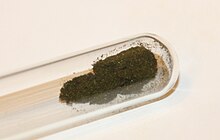Thymol blue
| Structural formula | ||||||||||||||||
|---|---|---|---|---|---|---|---|---|---|---|---|---|---|---|---|---|

|
||||||||||||||||
| General | ||||||||||||||||
| Surname | Thymol blue | |||||||||||||||
| other names |
|
|||||||||||||||
| Molecular formula | C 27 H 30 O 5 S | |||||||||||||||
| Brief description |
green solid with a phenolic odor |
|||||||||||||||
| External identifiers / databases | ||||||||||||||||
|
||||||||||||||||
| properties | ||||||||||||||||
| Molar mass | 466.59 g mol −1 | |||||||||||||||
| Physical state |
firmly |
|||||||||||||||
| Melting point |
221 ° C (decomposition) |
|||||||||||||||
| solubility |
almost insoluble in water (0.11 g l −1 at 25 ° C) |
|||||||||||||||
| safety instructions | ||||||||||||||||
|
||||||||||||||||
| As far as possible and customary, SI units are used. Unless otherwise noted, the data given apply to standard conditions . | ||||||||||||||||
Thymol blue is a triphenylmethane dye and belongs to the group of sulfonphthaleins. It is used as a pH indicator . Its phthalein analogue is thymolphthalein . The bromothymol blue can be represented by bromination .
properties
Physical Properties
Thymol blue is a green solid with a phenol-like odor and melts at 221 ° C.
Chemical properties
There are two color change points:
- pH 1.2-2.8: color change from violet-red to brownish-yellow
- pH 8.0-9.6: color change from yellow-greenish to blue
Thymol blue contains two hydroxyl groups and an unstable sultone ring . This ring is split in an aqueous medium, and after a rearrangement the quinoid yellow colored form of the dye is formed. In a strongly acidic environment (pH <1.2) the quinoid system is protonated, the solution becomes violet-red. In a basic environment (pH = 8.0–9.6) the hydroxyl group is deprotonated and the solution turns blue.
| species | H 2 In | In - | In 2− |
|---|---|---|---|
| structure |

|
||
| pH | <1.2 | 2.8-8.0 | > 9.6 |
| colour | purple red | yellow | blue |

|
|||
use
Thymol blue is used as an indicator in acid-base titrations. In most cases, only the second transition range (pH = 8.0–9.6) is used for the indication.
Individual evidence
- ↑ a b c d e f data sheet thymol blue (PDF) from Merck , accessed on February 20, 2010.
- ↑ Thymol Blue data sheet from Sigma-Aldrich , accessed on May 12, 2017 ( PDF ).
Web links
- www.chemieunterricht.de: Thymol blue .
- Website with 3D model of the molecule
